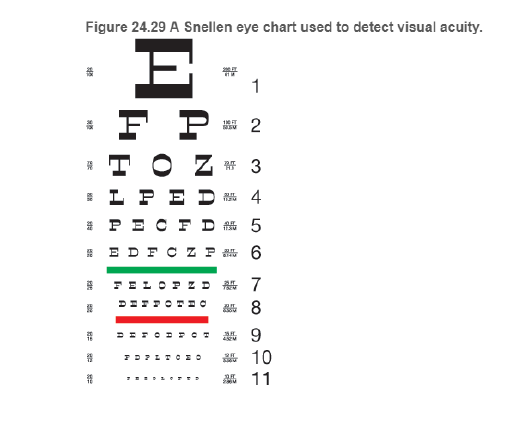
Concept explainers
BIO What is 20/20 vision? Vision is often measured using the Snellen eye chart, devised by Dutch ophthalmologist Herman Snellen in 1862 (see Figure 24.29). With normal vision (20/20 vision), you can distinguish a letter that is 8.8 mm high from other letters of similar height at a distance of 6.1 m (20 ft) (the Snellen chart in the figure is smaller than normal size). If your vision is 20/40, the letters must be twice as high to be distinguishable. Alternatively, a person with 20/40 vision could distinguish letters from 20 ft that a person with 20/20 vision can distinguish at 40 ft. Someone with 20/60 vision could distinguish letters at 20 ft that someone with 20/20 vision could distinguish at 60 ft.
Does the Rayleigh criterion limit visual resolution? Assume that the eye’s pupil is 5.0 mm in diameter for 500-nm light The Rayleigh criterion angular deflection for such light entering the eye's pupil is
If the Rayleigh criterion limited visual resolution, then from a distance of 6.1 m, you should be able to distinguish details in shapes of size
Suppose that a person with 20/20 vision stands 30 ft from a Snellen eye chart. Which answer below is closest to the minimum height of the letters the person can distinguish?
a. 4.4 mm
b. 6.6 mm
c. 8.8 mm
d. 1.3 mm
e. 1.8 mm

Want to see the full answer?
Check out a sample textbook solution
Chapter 24 Solutions
Modified Mastering Physics with Pearson eText -- Access Card -- for College Physics: Explore and Apply (18-Weeks)
Additional Science Textbook Solutions
Microbiology: An Introduction
Chemistry: The Central Science (14th Edition)
Biology: Life on Earth with Physiology (11th Edition)
Campbell Biology (11th Edition)
Campbell Essential Biology (7th Edition)
Microbiology with Diseases by Body System (5th Edition)
- Please don't use Chatgpt will upvote and give handwritten solutionarrow_forwardIf A - B = 0, then the vectors A and B have equal magnitudes and are directed in the opposite directions from each other. True Falsearrow_forwardIf the eastward component of vector A is equal to the westward component of vector B and their northward components are equal. Which one of the following statements about these two vectors is correct? Vector À is parallel to vector B. Vectors À and point in opposite directions. VectorÀ is perpendicular to vector B. The magnitude of vector A is equal to the magnitude of vectorarrow_forward
- No chatgpt plsarrow_forwardConsider the situation in the figure below; a neutral conducting ball hangs from the ceiling by an insulating string, and a charged insulating rod is going to be placed nearby. A. First, if the rod was not there, what statement best describes the charge distribution of the ball? 1) Since it is a conductor, all the charges are on the outside of the ball. 2) The ball is neutral, so it has no positive or negative charges anywhere. 3) The positive and negative charges are separated from each other, but we don't know what direction the ball is polarized. 4) The positive and negative charges are evenly distributed everywhere in the ball. B. Now, when the rod is moved close to the ball, what happens to the charges on the ball? 1) There is a separation of charges in the ball; the side closer to the rod becomes positively charged, and the opposite side becomes negatively charged. 2) Negative charge is drawn from the ground (via the string), so the ball acquires a net negative charge. 3)…arrow_forwardanswer question 5-9arrow_forward
- AMPS VOLTS OHMS 5) 50 A 110 V 6) .08 A 39 V 7) 0.5 A 60 8) 2.5 A 110 Varrow_forwardThe drawing shows an edge-on view of two planar surfaces that intersect and are mutually perpendicular. Surface (1) has an area of 1.90 m², while surface (2) has an area of 3.90 m². The electric field in the drawing is uniform and has a magnitude of 215 N/C. Find the magnitude of the electric flux through surface (1 and 2 combined) if the angle 8 made between the electric field with surface (2) is 30.0°. Solve in Nm²/C 1 Ө Surface 2 Surface 1arrow_forwardPROBLEM 5 What is the magnitude and direction of the resultant force acting on the connection support shown here? F₁ = 700 lbs F2 = 250 lbs 70° 60° F3 = 700 lbs 45° F4 = 300 lbs 40° Fs = 800 lbs 18° Free Body Diagram F₁ = 700 lbs 70° 250 lbs 60° F3= = 700 lbs 45° F₁ = 300 lbs 40° = Fs 800 lbs 18°arrow_forward
 College PhysicsPhysicsISBN:9781938168000Author:Paul Peter Urone, Roger HinrichsPublisher:OpenStax College
College PhysicsPhysicsISBN:9781938168000Author:Paul Peter Urone, Roger HinrichsPublisher:OpenStax College Physics for Scientists and Engineers, Technology ...PhysicsISBN:9781305116399Author:Raymond A. Serway, John W. JewettPublisher:Cengage Learning
Physics for Scientists and Engineers, Technology ...PhysicsISBN:9781305116399Author:Raymond A. Serway, John W. JewettPublisher:Cengage Learning Physics for Scientists and EngineersPhysicsISBN:9781337553278Author:Raymond A. Serway, John W. JewettPublisher:Cengage Learning
Physics for Scientists and EngineersPhysicsISBN:9781337553278Author:Raymond A. Serway, John W. JewettPublisher:Cengage Learning Physics for Scientists and Engineers with Modern ...PhysicsISBN:9781337553292Author:Raymond A. Serway, John W. JewettPublisher:Cengage Learning
Physics for Scientists and Engineers with Modern ...PhysicsISBN:9781337553292Author:Raymond A. Serway, John W. JewettPublisher:Cengage Learning University Physics Volume 3PhysicsISBN:9781938168185Author:William Moebs, Jeff SannyPublisher:OpenStax
University Physics Volume 3PhysicsISBN:9781938168185Author:William Moebs, Jeff SannyPublisher:OpenStax College PhysicsPhysicsISBN:9781305952300Author:Raymond A. Serway, Chris VuillePublisher:Cengage Learning
College PhysicsPhysicsISBN:9781305952300Author:Raymond A. Serway, Chris VuillePublisher:Cengage Learning





